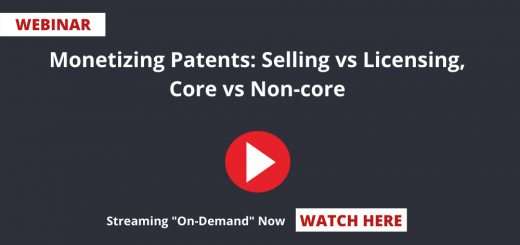How Strategic Use Of Business Knowledge Made Billionaires And Bankrupts – Webinar
Key points covered in the webinar (How Strategic Use Of Business Knowledge Made Billionaires And Bankrupts : CII-YI + Sagacious IP) session:
- What is IP (broad overview and simple definitions)
- IP as a revenue strategy, and IP as a defence strategy for Small, medium and large industries with diversified examples
- Famous case studies on Patents, Trademarks and Designs – This will include examples from various industries and across sectors
- Future of IP post COVID era in India. (How established industries not owning IP are under threat from MNCs having IP)
Table of Contents
Key-note Speakers
Tarun Kumar Bansal, President, Sagacious IP
Vivek Singh, Head – IP Filing and Prosecutions Practice, Sagacious IP
Tanmay Mittal, Head – IP Solutions – India Region, Sagacious IP
Moderated By
Mr. Anuj Singhal, Innovation Chair CII-YI
Submit Your Information to Watch the Webinar
Webinar Transcript
Anuj Singhal: Hi.Good evening, everyone. So, let me begin with this. A very thanks for taking out time. This is Anuj Singhal. I am representing YI Young Indians, Delhi chapter. I am the chair for Innovation Vertical. So, let me give you some context that why we thought of organizing this particular webinar that while doing our research and while asking that post-COVID-19, what the situation will be?
So, we came across some interesting facts that everyone is very optimistic about that post-Covid-19. There will be a lot of multinational companies which will start migrating to India, which is a very good news. But as we say, that every action comes with its own opportunities and threats.
So, when we started analyzing, that how India can be a leader with innovation. We came across something that was both, an opportunity and it was a big threat, which we could see. When we were taking the information out, so we came across our knowledge partner, Sagacious IP, which really helped. It’s one of the top global IP firms and they helped us to put together a presentation for us from the perspective of a business owner, specifically that why and how if we do not protect our business knowledge at this point of time, how can it be a threat towards survival and how can we use it as an opportunity to increase our revenue and profits also.
Who and Why Sagacious IP?
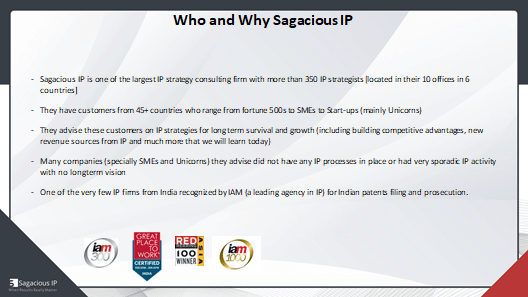
So, let me go with why Sagacious IP. So, I would really like to thank the team of Sagacious IP and the co-founders of Sagacious IP to share their global perspective because Sagacious IP is a multinational company. It’s an Indian origin, but a global company with 10 offices in 6 countries, more than 1300 clients out of 45 countries.
So, they just started opening up to Indian markets. Primarily, they have been working all across globe, giving strategic consultancies to all small, medium, large companies. Companies who were very small years back, like Amazon, Xiaomi. They have seen the complete journey that how IP has made these kind of organizations grow from small to large and large to unicorns and bigger large.
So today, I would further like to introduce, do we have Tarun with us, Mr. Tarun Bansal?
Tarun Bansal: Yeah. I’m right here.
Introduction of the speakers
Anuj Singhal: Yeah. So, let me introduce today’s speakers who have agreed to join, Mr. Tarun Bansal. He’s the co-founder of Sagacious IP. And I should say that a very true reflection of an Indian entrepreneurship mindset that Tarun is a first generation entrepreneur. So, 12 years back with the four people starting this company, today there are strong 300 techno legal IP strategists.
As I’ve already told you, that they have offices in 6 countries, 10 offices with 45 countries they operate in. So it’s a remarkable journey, Tarun. I’m sure some day we would call you to ask your entrepreneurship journey also. So, Tarun is from BITS Pilani. Tarun, it was like 2014 when you were CNBC young truck or 2015?
Tarun: I think 2014.
Anuj: Ok, 2014 and Sagacious has been awarded as one of the best places to work and he is one of the top 300 IP strategists recognized by IAM.
So, we have Tarun who will be sharing a lot of insights. And today we have made sure that this session is more for business owners and strategic discussions and less of technical aspects of IP. Today we are not going to talk about trademarks, patents and copyrights in detail as a technical subject. But today we are going to talk about why India is not a leader in innovation, why Indian business owners are not able to identify and protect their business knowledge.
So we are going to use a lot of case studies and second speaker, we have Mr. Vivek Singh, can we have Vivek’s profile? Hi Vivek, thank you for joining.
So we have Vivek with us. He is the head of Indian practices at Sagacious IP. So, Vivek is also a lawyer and he’s a member of Bar Council, Delhi High Court. And he is also recognized by IAM as one of the top 1,000 IP attorneys across the globe. Vivek used to head IP division at FICCI and also while working at FICCI, he was one of the instrumental partners with Government of India informing the IP policy of India. Am I right Vivek?
Vivek Singh: Ya, I was part of FICCI at that point of time when this India’s first national IPR policy was announced in 2016. So, I collected the views from industries and submitted it before the government.
Anuj: Vivek also have different hats that he also started a farmer start-up which later he sold to 1mg because I think his first love was IP. So, I’m sure we hear a lot of litigation matters and we hear a lot of environmental of law governing in India about IP from Vivek.
So Tarun, I think I leave the floor open to you. We have a lot. We are looking forward for you to share live case studies and examples with us that why it is important now for all the business owners to use IP as a strategy and not only as a technical. So please Tarun, I’ll leave it to you. Please go ahead. Thank you so much.
Tarun: Hi, everyone. I’m really thankful to CII-YI for this opportunity because they really think that Indian entrepreneurs have, what it takes to be global leaders. The only thing is there are some gaps, there are some ignorances that we will cover today, we will kind of unearth today.
What we are not covering in the webinar?
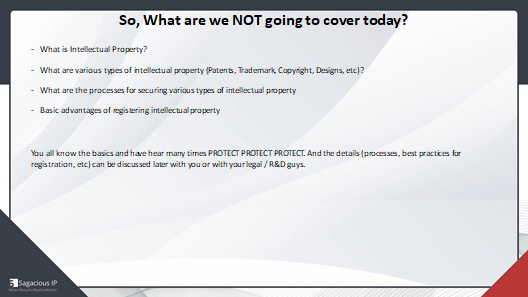
So, before we start, I just wanted to highlight that what we are not going to cover today. As Anuj already mentioned that we will not be covering the basics of intellectual property. What are various types of intellectual property? We will not be covering the process for securing various types of intellectual property. We will also not be covering the basic advantages that you get from registering the intellectual property because I’m very sure being business owners, you come across many IP law firms and they always preach you, protect, protect, protect. Most of the times you kind of redirect to R&D and legal guys to take care that.
What is covered in the webinar?
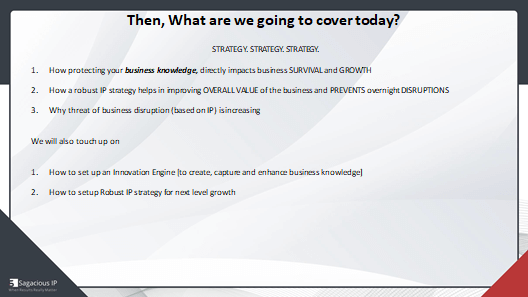
Our focus today will be strategy, strategy, and strategy. So, the main focus will be on seeing that how we can protect our business knowledge and how it can directly impact our business survival and growth. We will also cover that apart from protecting the business knowledge that we already have. So, we are already generating a lot of business knowledge. But apart from that, what are the other components of IP strategy that can help you achieve a better overall valuation, as well as prevent overnight disruptions that have happened multiple times across the globe.
We also want to cover, you have been running your businesses for quite sometimes. Some of you may be running these businesses for decades but we wanted to highlight that why right now is the most dangerous time if you do not do anything about it and why current time is also the most important in terms of opportunities that we have.
We will briefly also touch upon as I mentioned, you should protect your business knowledge. But some of you always think that we don’t have any business knowledge that can be IP worthy. So, we will also touch upon how to set up an innovation engine because you are in whatever business, there is always innovation happening. The only thing is we do not value it sometimes or even if you value it, we do not have any kind of processes in place so people can contribute. We can identify those innovations and can get advantage of it.
So, we will briefly touch upon that how you can set up an innovation engine to create, capture, and enhance business knowledge. We will also touch upon that how you can set up a robot IP strategy for next level growth.
And before I go forward, I just wanted to highlight and put a Disclaimer that we will be actually using logos of many companies because my presentation will be more storytelling and I’ll be actually using a lot of case studies and purposefully I have selected case studies which are very relatable to you. So I have companies from Faridabad, I have companies from Noida companies from cities like Bulandshahar, cities like Moradabad.
So you can actually relate to them because I think most of the times you hear about Samsung, you hear about Microsoft, you hear about all the large companies, Siemens and all those kind of companies, rather than hearing about your peers.
So the Disclaimer is that we will be using a lot of logos, but that does not mean we own any of those logos or they endorse what we do.
Start with a question
Name the Mobile company that became largest in India in 2014.
Tenth largest in 2010s
Hardly exists now
The first thing I wanted to do was I wanted to start with a question. So, I just wanted you to think a little back in time in time. Name the Indian mobile handset company that in 2014 became largest in India. It even surpassed Samsung, which has been a leader in Indian market for quite some time and also at one point became 10th largest in the world, including in countries like Russia. But it has hardly any existence now.
I’ll just show the name. So, as you can see, the company that I’m talking about is Micromax, which was one of the largest homegrown brand in mobile handset. And it became really big and I think we can credit Micromax for taking the mobile handsets to the masses because they were the first ones to launch economical and cost-effective handsets that was adopted by India. So, kudos to them, but they could not keep up.
But at the same time, here is another question. So now guess the companies that hardly had any name in early 2010s and are now giving Samsung and Apple run for their money in India as well as globally. So, Samsung and Apple, as we know, are the biggest companies but these companies are giving them a tough competition. In some quarters, they are surpassing the growth of the sales of Samsung and Apple as well. So, if you can name those companies correctly, most of you would have guessed it. Some of you may be using these brands even now for typing those answers.
So these brands are Xiaomi, which has surpassed Samsung sales in many quarters and now including in the high end forms. So earlier it was considered as a low-end brand. But now they are surpassing Samsung sales in even the larger or more cost layer segments.
Similarly Vivo and Oppo and you would be surprised to know one thing that Vivo and Oppo, they look like that they are competitors and they are two different companies. But if you trace their organization chart, you would realize that they are owned by the same company. So, this is how these guys actually use a lot of innovation and strategy, including the business strategy and even the One plus that you see is another big brand. So, that is also part of the same group which owns Vivo and Oppo. So, they have some kind of a shareholding arrangement with each other.
Anyways. Now Let’s hold that thought and I will show you some statistics. My major thought today is that why is it that Indian companies are not reaching globally. Why is it that Flipkart is fighting Amazon in India but Amazon is not fighting Flipkart in US? Why Flipkart is not going to US? Similarly, why do not we have any Mi or let’s say a Vivo or Oppo kind of companies? Why don’t we have companies who are leading their marks globally?
So, do you think that our Indian talent is not good, or do you think we are not ambitious, or do you think our business leaders are ignorant? So, I’m sure that most of you will disagree with me that these three are not the reasons. Then what is the reason we have to really dig deep into it? and that is what we will be covering today.
We have to kind of make a mark. We have to make the $5 trillion economy dream truth and we are the ones who can do it. And I’m very sure CII YI is one such organization that has deep reach and if members of CII YI adopt these kind of practices nothing can stop the growth of India.
Some Stats
Patent Filings and Grants are Dominated by Foreign Applicants
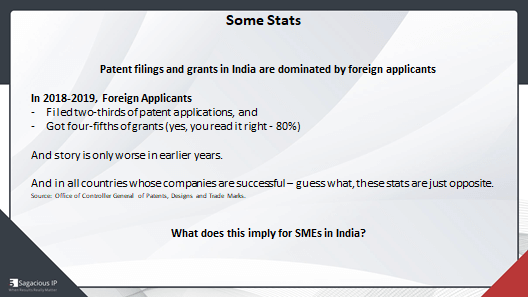
Now, I’ll just show some disturbing statistics because they are there. So, patent filing and grants in India are dominated by foreign applicants. In 2018-19, which is the last financial year. Foreign applicants file two-thirds of the patent application, that’s 67% and got four-fifths of the grants. So finally, the patents that were approved by the patent office. So almost 80% of the patents, you read it right. 80% of the patents were granted to foreign applicants and only 20% were granted to Indian companies.
And unfortunately, even amongst those 20%, the most share was for universities who wanted to just show the lot numbers in their brochures as well as by the government research institutes like CSIR who have the mandate to do so.
So we are really, really lagging behind in innovation in IP, and we have to change that if we really want to become big because I see that I travel to a lot of countries. When I go to, let’s say Latin America or go to Central American countries or go to, let’s say, African countries. So that’s where you can still find some Indian brands which are very popular, like, Mahindra, Tata, Bajaj. So, you can find those brands.
But at the same time, when we go to the countries where the paying capacity is really high, let’s say we go to Europe, we go to the US, we go to maybe Australia, Singapore. Chances of finding these brands at such a level are very, very low. So, there has to be a reason and we will cover that all today.
As I said, it was 2018-19. And if you go back in time, the story was only worse. If you compare the countries whose companies are dominating even Indian market like US companies, Japanese companies, Chinese companies now dominating Indian market. These States are just opposite. 80% filings are by their domestic applicants and only 20% filings are done by the outside companies.
So what does this imply for SMEs in India? Unfortunately, I have to call that they’re surviving on the mercy of MNCs. They can disrupt their business anytime because they have 80% patents granted to them and in lack of IP strategy I’m very sure a lot of MSMEs in India are infringing their rights, and time is only right when they can enforce those rights and kind of disrupt the businesses.
Some stats on SMEs
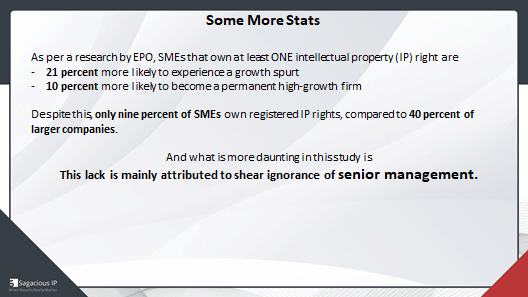
Some more stats from the same study. So as for our research by EPO, SMEs that own one intellectual property right are 21% more likely to experience a growth spurt, 10% more likely to become a permanent high-growth firm. So IP when I say, it can be patents, it can be trademarks, it can be designes, it can be copyright, but most enforceable ones are patents, trademarks and designs. So, we will focus mostly on them today.
Despite this statistics that 21% chances are there to actually become a high growth firm, only 9% SMEs own registered IP rights compared to 40% of the larger companies. So out of 100 SMEs, only 9 will have IP. Similarly, when it comes to larger companies, out of 100, 40 will have some IP. And the biggest daunting thing about this study is this lack is mainly attributed to sheer ignorance of senior management. So, it’s hard to digest, but the problem is that we are ignorant, the top business leaders, the business owners are ignorant. And I’d say the highest form of ignorance is when you reject something you do not know anything about.
So as you know, IP often comes up, innovation often comes up and you say that here this is good, but you simply reject it. You close your eyes, you shut your ears and you say that our business is going good, let’s go ahead with this. So, this has to change, senior management has a key role to play if we really need to win this war.
What Senior Management Thinks About IP?
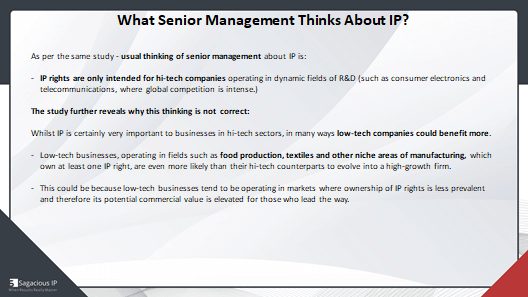
Now, according to the same study, what is the major thinking of senior management? Why do they kind of reject this without digging deeper into it? So the usual thinking is especially for the SMEs, I see that we have a lot of companies today with us who are in textiles, who are in tracking, who are just trading some commodities.
So, most of you think that IP rights are only intended for high-tech companies operating in dynamic fields of R&D such as consumer electronics, telecommunication. Their global competition is intense, so unfortunately, the thinking is not correct. While IP is certainly important in those segments, it is even more important in segments like food production, textiles and other niche areas of manufacturing. And for any of these kinds of companies, the low tech companies own any IP, they are even more likely to experience growth because its competition is very less globally.
Two Parts of the Journey
So I hope with this thought, I can take you to the journey of survival and growth via innovation and IP. As I already mentioned, this journey has two parts. First is, creating innovative business knowledge and leveraging it for growth. So you have to create a process where you actually generate more innovation. You generate more innovative business knowledge and more importantly, you generate it and you identify it, and once you identify it, you further enhance it and protect it.
So, IP in protection is just a side business. It’s just a side effect. The major thing is identifying that we are doing innovation is important, and second part is having a well-rounded IP strategy. So even if you are right that you cannot generate any IP, it might be correct in some cases, but what you can still do in terms of IP to lead the growth globally. So I’ll take it in two parts.
Why Protect Business knowledge?
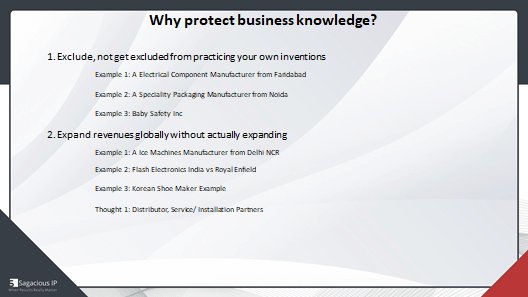
Let’s begin with the first part. So why protect business knowledge? So, first thing I want to highlight is you have to exclude others and not get excluded. The problem is if you do not affect your business knowledge, you will be excluded for practicing your own inventions.
I’ll give you one example. So the first example is an electrical component manufacturer from Faridabad. So, these guys were actually into producing some switches, and I’ll use a mix of Hindi and English as well. So, they had an RND team and this R&D guy actually invented something really beautiful and the company wanted to invest and produce products based on it. Suddenly R&D guy realized that I would leave and protect my IP on my own and he left the company. He protected the patent on its own. And the company was excluded from practicing its own invention mainly because they did not have any IP regime. And the biggest problem was their agreement with the employees did not cover any IP clause, allowing them to take care of their own inventions and file them separately.
So I think even if you think that IP is not important, I should not protect it, it will not harm my business. Just think about having the right IP clauses in your agreements with your employees. So if you invent something, you are not excluded from practicing that. Another very simple example is a speciality packing manufacturer from Noida. So, these guys actually produced a lot of packing materials for long-haul transport as well as a few other things. And they actually came about a honeycomb package design that they thought is really good and they started manufacturing it and started selling it without thinking about IP without thinking about anything. And once they gained some market traction, they were immediately sued by an American company who filed an IP on that particular thing in India as well.
So, it might be entirely possible that this company from Noida came up with this idea at the same time, the US firm came this idea about, but because it’s always first to file, they filed the IP, and they could exclude this company from kind of manufacturing this packing material.
Third is one example from my own company. So, I separately own one company in baby products we also get a lot of our new designs manufactured in China. And, you know the bad habits of Chinese, they will actually take your design, and they will start selling globally without your permission and you cannot enforce your rights in China.
I know one of my clients who tried to enforce his rights in China. He is now seeking bail in China because he was actually arrested just for enforcing his IP rights. So be careful. But at the same time, the most important thing is protecting those IP rights in the markets that matter to you. So if the market that you look for is India, you should protect your IP rights in India. So, you can exclude if someone is buying from those manufacturers. So you can terminate the contract with the manufacturer, but that will not help you actually carve the competition from an unknown brand in India.
We are one of the largest brands in India for safety gates for kids. And we realized that our manufacturer, whom we were giving our custom designs, was applying it to some other companies in India. So we could actually enforce those rights against those companies in India, even if we could not enforce it in China. So, my main point with this was that exclude and not get excluded.
Second point is expand without expanding. So it’s very important to know that if you have some innovations, you are protected in India, you think that your market is India, but you can still think about expanding to other countries like USA, Europe and any others without actually expanding there and just generating some licensing income.
There is an ice machines manufacturer from Delhi NCR, I think in Manesar. So these guys actually came about and produced a very great ice manufacturing machine. They did a nice tweak based on which the cubes do not stick together. So, once you see that ice cubes are there, so they stick together. So their invention was they do not stick together and it was a really good method. So, they patented it.
They are doing their business in India. But they also filed a patent in US. Now they thought, let’s file in US. They filed in US and then they approached us that we have this patent in US, can we get some licensing revenue from this? And you will be surprised we took it to one of the largest ice manufacturer company in US. In US as you know, even if the temperature is -20 degrees Celsius, they will drink water, which is ice cold, ice cubes. So it’s a huge market.
He saw the invention. This guy jumped out of his chair and he said, if I get this invention, this will add $80,000,000 to my annual revenue. They are proceeding with this licensing deal and it might mean $5,000,000 to $8,000,000 US annually in licensing income.
Another example is Flash Electronics India versus Royal Enfield. Both are Indian companies. But Royal Enfield has a market in US and many other countries. So, Flash Electronics filed some patents globally. So now they sued Royal Enfield in US, and they are planning to Sue Royal Enfield in 10 more countries to generate licensing income, even though they have no market presence in those countries.
Then another is Korean Shoemaker. So, this was a very simple invention. They created something that you can attach and detach heels for a lady’s shoe. So, this guy came to us that can we license it to some person, I have market only in Korea, but I think this can be used globally. So we looked at it. We were laughing. That okay, what is this? This is very simple invention but when we started doing some market research, we realized that it’s I think a couple of billion dollars market every year, the women’s shoe. Then we got serious about it. We were able to license this particular technology to an Italian shoemaker, which is where a luxury segment Shoemaker.
There is one thought because a lot of you are distributors and installation partners for some larger companies. So, I have a thought because a lot of doctors I see patent their own invention. So they use medical devices produced by larger companies when operating, they actually come up with new ideas, and they patent those improvements. Most of the times they license it back to the medical device company generating additional revenue.
So same is the case with the distribution or trading companies. If they are trading and their installation, they’re installing, they’re doing servicing. They actually come across the actual customers and there are many times your installation teams will come up with newer ideas. So, that’s where if you can identify those innovations and you look at your distribution agreement carefully, and if it allows you, you can actually protect those improvements and can license it back to those companies as well. So, that was more about why you should protect your business knowledge.
Corelating Business Knowledge and IP Rights
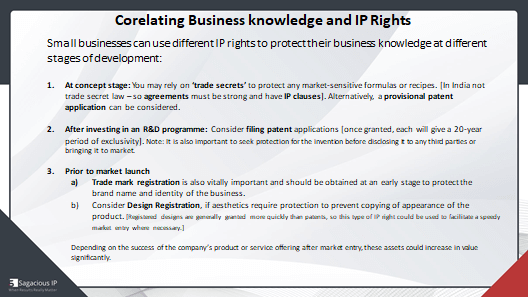
Now I want to correlate business knowledge and IP rights. So I’m saying business knowledge, business knowledge. But what is this business knowledge and what it has to do with IP rights? So I see that small businesses can use different IP rights to protect their business knowledge at different stages of development. So for example, if you are at a concept stage, you may rely on trade secrets to protect any market-sensitive formulas or recepies.
But do remember, India does not have any trade secret law. So, if you have to really rely on your employment agreement, you have to have proper IP clauses and very strong agreements. Alternatively, you can also file a provisional patent application where you do not need to disclose much information, and you just can protect the concept broadly at that point.
After you have invested in an R&D program, you should consider filing patents because once they are granted, they give you 20 years of exclusivity. Most important thing here is you have to seek this protection
before you disclose it to any third party or you start marketing that product. Like the Noida company, the packaging company, they started marketing it and they never filed the IP.
Third is before you go for market launch. Important thing is to see that whether the trademark or the brand name that you are thinking is available because we have seen many cases where they launch the product under a brand name, get sued and later on have to let go of all the marketing spend on building their brand, and have to change the brand at a later stage. So identify whether the trademark is available for registration and register that. Also consider design registrations if you think the look and feel of that product is important because design registrations are quickly granted, this can give you quicker market access. So essentially these things can really increase the valuation of your company.
Now I think I might be reading your mind in some cases because I have been talking to a lot of business owners. So some natural thoughts here could be that oh we don’t have any IP worthy business knowledge, and there is no way we can create it in our industry. A lot of people think that and IP will consume too much resources without much output. So that’s what some of the people think.
The next two top objections are. If I file IP, I will reveal my trade secret, which is a very, very genuine thought that if you file your IP, you are going to produce all the invention in front of public and anyone can use it. So, if you think that this particular thing you cannot detect infringement on, so if it is a process which is to be performed in a factory, so we generally recommend that you keep it as a trade secret.
IP strategy is not always about protecting by patents. It has to consider what you want to keep trade secret and how efficient your system is to keep trade secrets. So which is a good thought and you should not let it dilute.
Some people may say I support open source then why IP. I just want my knowledge to be free for everyone to use. I think you read me that you can be excluded. You don’t file IP somebody else might. So if you see Linux or Red Head, which has been a very popular open source OS, they hold close to 5,000 patents. They were sold to IBM very recently. But they hold 5,000 patents just to make sure no third party can own those rights and can exclude them or anyone else who they want to give open access. They cannot exclude them.
Solution for Top 2 – Setup Innovation Management
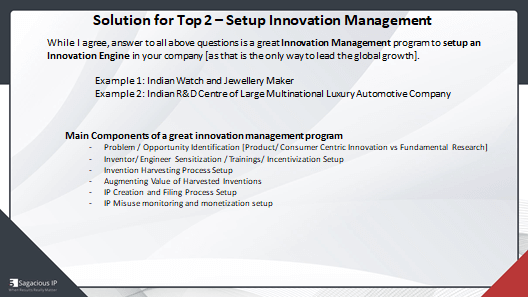
Now, I just want to briefly touch upon the solution for top two because that’s more of a cultural problem that you cannot create IP, any industry. Even if you’re running a small shop, there is IP in it. There is some innovation in it. You just need to have the right process.
So while I agree, that answer to all about questions is a great innovation management program. So you have to set up an innovation engine in your company as that is the only way to lead the global growth. That’s what these companies do.
Oppo, the Chinese mobile maker has become the largest patent filer, the fifth largest patent filer globally now. So last year, they filed 5th highest patents across the globe. So they are thinking that ways.
Now one example I want to take from the leading watchmaker and jewelry maker from India. It’s one of the largest brands in India. So, these guys we met and they thought we are not doing anything IP worthy. What we will do with the IP, will file just design rights. And their inventors were not very highly appreciative of that, that they are doing something world class.
So what we did was we said, OK, that’s what you think. Let us show you some landscapes. Let us show you, let’s say your competitors like Swatch from Switzerland or Rado or those kind of companies, Cassio from Japan. So what kind of patents these guys are filing? Let’s look at them. And we start started showing them the patents they have filed in the last two years.
These guys literally jumped out of their chair and they said they are protecting these stupid things and we are doing these things day in and day out. So we do not have neck of what is IP worthy? We do not know what is good IP because we always think that this is all ‘a hack’. So we have to come out of that mentality.
Even the larger companies. So this is an example of Mercedes Benz Daimler, whose Indian R&D Center was not creating too much IP because inventors are not that motivated. They think they are not doing something that is IP worthy.
So again, be it a small company, be it a large company who has very good IP process in their home countries. Everybody is failing because we have to change the mindset. We have to create those processes and that’s where we are actually leading the way at Sagacious IP.
Just to briefly touch upon, as I said, I’ll touch upon innovation management program and how to create an innovation engine. It just has five components. The first one is you have to clearly identify problem and opportunity that you have to work on. As well as you have to divide your inventions into two phases.
One is the inventions you are doing for market capture or just beating your competitor. You have to improve the design. So these are short-term innovations. And second thing is fundamental research. So where you are trying to change the industry totally. You invest in fundamental research for long term and you invest in problem or product or consumer centric innovations in short term. So most of you may be doing a lot of product and consumer centering innovations. You should make a process around it first, and then you can move into the fundamental research part.
Second part is inventor or engineer sensitization, trainings and incentivization setup. So you have to set up that particular process. You have to set up the invention harvesting process because inventors will not come to you and say that we have created something new. You have to set up a process, so you can capture their mind. You can capture their new inventions and then you should have a setup where you can give proper feedback to those innovations and then can announce the value of those innovations. And finally, you can create the IP and file it depending on your market and your ambitions and finally, you have to actually do IP misuse monitoring and monetization set up. So, that’s the first part of the journey.
Now considering the time is running out, I will be fast and go to the second stage of the journey, which is using well-rounded IP strategy for global sustainable.
Anuj: Tarun, Just a very quick thing for this innovation management strategy. So what you’re saying is that it is very much applicable and doable for SMEs also. Am I correct?
Tarun: I would say SMEs as well as the micro-enterprises also.
Anuj: Ok micro-enterprises also. So this is kind of set up that it’s more of a mindset challenge. So everyone can I properly follow that, it can be done. It’s a doable thing, right?
Tarun: It’s a culture change. It’s nothing very complicated. It’s just a culture change.
Anuj: Okay. Please. I just wanted to do double-check.
Using Well Rounded IP Strategy for Global Sustainable Growth
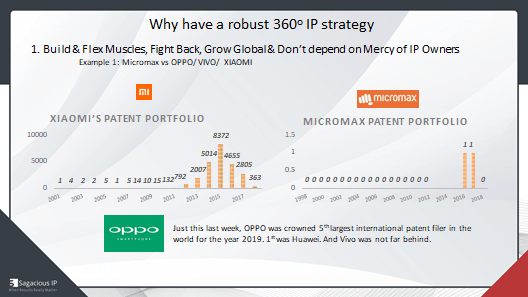
Tarun: Now section two using well-rounded IP strategy for global sustainable growth. So again, as I said, creating your IP is time-consuming. It requires a lot of resources to do R&D. What else can you do to basically create IP quickly and get the leading position?
Build and flex your muscles
First thing is very important, you have to build and flex your muscles. If you be timid and you are just defensive, it will not work. You have to build and flex your muscles. You have to fight back. You have to grow global and you do not have to depend on Mercy of IP owners. That is the worst thing to do.
So, here I want to show you the example of Micromax, Oppo, Vivo and Xiaomi that I already discussed initially. So what Micromax could not do so they could not do any in house and to keep pace with the ongoing development. At the same time, they did not take the short term approach that Vivo, Xiaomi and Oppo took very, very strongly and we supported them in that approach. So we know the journey very first hand.
If you look at the patents that Micromax holds are just two patents. So they had no focus on IP. While if you look at Xiaomi’s patent portfolio, they have patents in thousands. So they started with the IP journey. They were not creating any IP in the initial years till, let’s say, 2010, they were not creating any IP, but then they realized if they have to fight Ericsson, if they have to fight Samsung, if they have to fight Qualcomm, they have to do something about it if they cannot create that much IP quickly. So what they started doing was they started acquiring IP. A lot of IPs available globally. Everybody does it. Uber did it. Amazon did it because they were new companies in the market. They got the market share very quickly.
They had to do something different. They cannot create that much IP so quickly, R&D takes time. So, all these guys actually started acquiring patents from individual inventors, from smaller companies. And what they did was they acquired only those patents that were infringed or that were actually used by Ericsson, Qualcomm or any of those companies who they thought will sue them.
Xiaomi, for example, was buying patents left, right and center for mobile apps. So Let’s say you see those mobile apps where you show your face in the camera and it’ll actually add, let’s say a kitty face or let’s say Padmavati or those kinds of things. So, Xiaomi bought all those patents from individual inventors because Samsung mobiles were supporting those apps. So it can go and sue Samsung that you are actually giving support for these apps. So, they took a very, very stringent IP approach. They took a very, very intelligent IP approach that’s what is needed with Indian SMEs. They cannot innovate that first, I understand, Innovation Management program will take time to show up.
But if you really want to go global, that could be one way that you can do. Like the Chinese companies as well as the other well-known companies like Uber and Amazon did. Oppo, for example, so I have not shown Oppo’s patent growth, but again, they had the same graph as Xiaomi. They set up the innovation program, which took time to show. But this year, 2019, they became the fifth largest global patent filer in the world. I’m not talking about China, I’m not talking about Asia, I’m talking about globally. They surpassed most of the companies like Apple and many others. So, that is something we really have to learn from them.
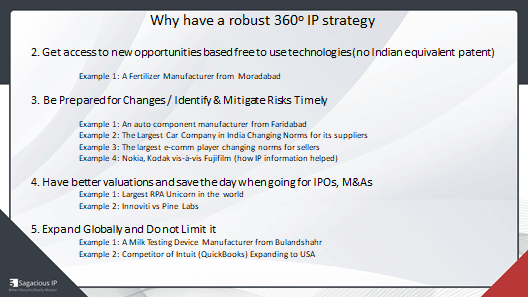
Get access to new opportunities based free to use technologies
Second thing is get access to new opportunities based on free-to-use technologies. So, as you will see here, that China is filing 600,000 patents annually. US is filing, let’s say 450,000 patents annually. Europe is filing 300,000 patents annually. Japan is filing so many patents and India is filing, let’s say only 80,000 annually.
So, I would say that this is an opportunity as well because there are so many patents which are not filed in India. There are close to, let’s say, 1,000,000 patents which are not filed in India annually and those technologies are world class, they are leading and they’re free to use in India. So, for micro enterprises, small enterprises, it’s a good opportunity to look at those technologies in their areas and get inspiration and start practicing those things and capture the Indian market based on those weak technologies. So. that’s one part of IP strategy to utilize IP intelligently.
I would give an example of a Fertilizer manufacturer from Moradabad. So, this guy was very intelligent. He went to South Africa for a business tour. He saw something there and he said, Yeah, this is a good technology, this can work in India. And he came back and he said, Give me a landscape of technologies in my field which are globally available but have nothing in India, I don’t want to get into IP infringements. And he identified one particular technology that was really good. And he made close to $5,000,000 in annual revenue by launching the technology. It was, I think, 2013 or 14.
Be Prepared for Changes or Identify & Mitigate Risks Timely
The third thing about IP strategy is that you have to be prepared for changes and you have to identify and mitigate risks timely. You cannot just keep waiting. First example, I’ll give an auto component manufacturer from Faridabad. So as you see that now, the norms are changing from BS 4 to BS 6. So, these guys never thought, they thought, okay, we are set, we are supplying. And now, when the norms were enforced by the government that it has to change from BS 4 to BS 6, they had no IP. They had no negotiation power and now they are really struggling what to do because nobody is ready to kind of license them anything. Nobody is ready to supply them anything that they can supply further to their buyers. So, you have to really be prepared from early on.
Another was one largest car company, Maruti. So Maruti is still the largest in India. They changed their norms, especially for MGA, Maruti Genuine Accessories. They were procuring products from many vendors, and these vendors were dependent on Maruti heavily. Suddenly, Maruti said, we will not sell anything that will infringe IP. So first submit an FTO report that your products do not infringe IP, especially in the countries that you supply, and most of them were supplying to Asian countries like Thailand, Vietnam as well as India.
We saw a sudden rush of companies coming to us asking for freedom to operate research. A lot of companies faced a lot of difficulties when they had no freedom to operate. Of course, they never had IP, so they could not really claim the exclusivity. But because they did not have freedom to operate, they had tough time negotiating with Maruti, and they lost significant chunk of their business.
Third example is largest e-commerce player, Amazon, changing norms for sellers. So as you see, Amazon sellers are earning in crores, if you talk about India and some sellers are earning in millions, if you talk about US. Amazon suddenly said, we do not want to be caught into counterfeit things. So first, you have to confirm that you have the registered trademark owned by you.
So, many sellers were kind of unaware we never registered trademark because earlier you could register on Amazon as a seller without a trademark. So, suddenly their business faced so much difficulty because those trademarks are not available for registration. They never checked whether this is available or not. They were just doing business.
In US they went a step further. They said, even for the product, you have to submit the FTO reports that you are not infringing any patents, and a lot of sellers lost their business there as well. They did not enforce it very strictly. But lot of sellers had problems, Walmart and a lot of those kind of large stores, their vendors also face problem. And those companies actually enforce such things.
Anuj: Tarun, I would like to just come in for a little bit, maybe very relevant examples we are having. In fact, we have some requests from the participants. So, there is Mr. Mamo Mohan, who have asked that, can you give any examples for if IP is possible in hotel industry and in restaurant chain? If any example which comes to your mind?
Tarun: So I have some examples in the future where I’m comparing Airbnb and Oyo. Airbnb holds a lot of patents while Oyo has nothing. So we studied the Airbnb portfolio right now, but I can take that question up later.
Anuj: Okay, sure. Then let’s move forward and let’s move fast.
Tarun: Right. So now example 4 is very common. I think all of you know that Nokia was a leader in smartphones and suddenly they went away. Kodak was a big company in, let’s say, steel cameras and they went away. And you also know Fujifilm, whose films people using in the cameras, the regular cameras. But they did not go away. They became even bigger.
So IP played a major role there. They were very Proactive. They actually saw the trend. Nokia never saw the trend, and they were too adamant that we are the leader, and we will actually keep doing what we want to do. Kodak was in a similar situation but Fujifilm was very intelligent. Fujifilm, what they did was they actually started looking at the IP landscape. They knew that the film business is going to go, but they had a lot of patents around chemicals because a lot of chemical processing is happening in films.
So they thought, why not identify opportunities based on the IP and technologies that they already own and identify which other markets they can supply to. So they did the study. They studied the IP landscape. They upskilled their workers and they immediately moved into chemicals and pharmaceutical industry. And they are a big player now there.
Kodak and Nokia kind of just vanished while Nokia is still surviving because of its IP because they have very core patents in telecommunication because they were the first mover. So right now, the most value they have is an IP.
Have better valuations and save the day when going for IPOs, M&As
Finally, the fourth point is have better valuations and save the day when going for IPOs and M&As. So, outside India, it’s a very common practice. Their companies will come and sue you just before you file for an IPO or you’re going for an M&A. They will sue you for IP infringement. So, if you do not have any IP, you do not have an IP strategy, you are just at their mercy because your investors will lose confidence and your IP will be a big failure.
So I’ll give you one example. So we serve one of the largest RPA unicorn in the world. RPA is Robotic Process Automation. It’s called UI Path. So UI Path is the largest in this phase with a $15,000,000,000 valuation. So, billion with the capital B. So they have a $15,000,000,000 valuation. They were thinking of going for IPO. When this news went out, they started getting threats from IP owners and these guys had no IP.
Now you understand they are $15,000,000,000 company with 10,000 plus clients, have many market releases with zero IP. They started getting threat letters. Their senior management woke up that ok, this is something serious. They started looking for companies who can support them. We reached out to them. We worked with them and we set up an innovation management process quickly. And senior management supported very wholeheartedly.
They had our R&D centers or development centers in 26 countries. So, we actually visited many R&D centers. We did a lot of video conferences, and we identified 200 good IP worthy ideas based on the releases they had done in the last one year. We filed 90 high quality patents. But this was not enough because Microsoft was fast approaching this market and Microsoft had a big portfolio that they can sue and just make this company go away. So, what we also did was we identified 2 or 3 other companies who had good patent portfolios which were infringed by Microsoft. We were able to get a better position.
Another example is two Indian companies, Innoviti and Pine Labs. So Innoviti thought that they want to go for the IPO. They sued one of the Unicorns Pine lab from India and this gives their inventor’s confidence that they can actually get a better market share in the future. So, it might be a good idea to enforce your own IP right when you’re going for an IPO yourself. Finally expand and do not limit it.
Expand Globally and Do not Limit it
So as I mentioned, a lot of Indian companies do not go to developed markets like Europe or US because they really fear legal disruptions as well as IP infringement.
Here, I would like to quote the example of a Bulandshahar company. It’s a milk testing device manufacturer. They developed a new device and they wanted to actually supply to one of the largest milk testing facilities in Europe. But they knew it’s a problematic thing. So they were very Proactive. They filed for IP on their earlier design, but they also asked us to do freedom to operate search. They asked us to check if they supplied to Europe, will there be any problem. They identified, there could be some problems. So, they immediately ask their R&D teams to see if they can design around and overcome that infringement. They did that. They filed for IP on the new design, and they participated in that particular contract, and I think they might be supplying 3,000 to 5,000 machines to that plant in near future. So this is all about IP strategy. There are many examples I’ll skip now because I think I have put across the point, I think.
So, What’s next?
Anuj: We have some questions coming up, and the time is running short. So anything you want to touch base upon, or maybe we can just move to litigation.
Tarun: I think two more minutes will be enough to wrap this completely.
Anuj: Ok, after that will be move to Mr. Vivek to just touch base and give some idea.
Set up Robust IP Strategy
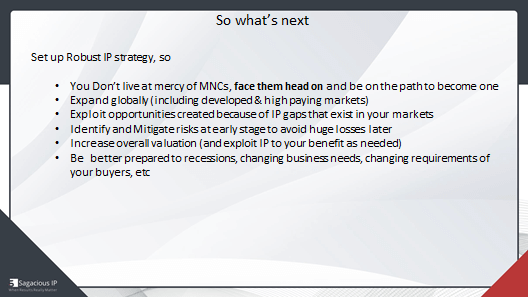
Tarun: If you are setting a robust IP strategy. You know why this is important. So you don’t live at the mercy of MNCs. You can expand globally without hearing infringement and legal hassle. For example, one of the largest messaging company from India. They did not even expand to US. So, it was a messaging company which was giving tough competition to WhatsApp and they had some NRI users. So Indians living in US who were using their service and they got sued badly in US just because of that. They had to spend millions of dollars on that sued.
So it’s very important to keep in mind all those points. Even if you’re operating only in India, you can still be sued in some other countries if you’re operating over the Internet.
I think rest of the points I have already covered. But last point based on this, you can be better prepared for recessions, changing business needs and changing requirements of your buyers.
Why Threat of IP Litigations is Increasing?
So now, finally, I wanted to say that why threat of IP litigation is increasing. Again, I wanted to read your mind. We have been doing this business for decades and never had such problems. What will happen now? What is so different now? And I don’t care, my business as it is as good. I have no interest in expanding further. So, why should I care about IP?
So, second point is fine. If you do not want to expand further, just make sure you are not disrupted and you just be prepared for that. But for the first one, I think there are a few points that are very important.
Why Threat is Increasing?
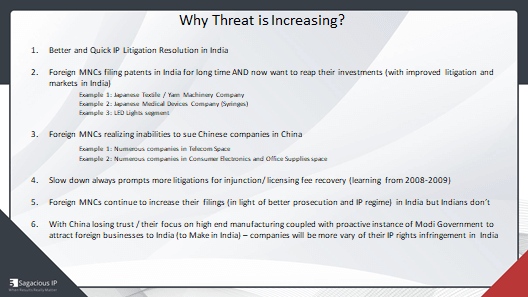
Why threat is increasing because there is a better and quick IP litigation resolution in India. Indian government is very pro IP now. They are setting up separate IP courts where IP resolutions are happening faster. And because of that foreign MNCs, those who have been filing patents in India are spending a lot of money now want to reap the benefits, wants to sue the companies in India.
I met a Japanese textile machinery manufacturer. They make a lot of thread winding or rayon winding machines. So, they wanted to enforce their patents in India because they see a lot of Indian SMEs are manufacturing similar machines or using similar machines.
Same is the case with the Japanese medical device company making some syringes. So, those syringes are patented in India. They never came here because they thought litigation is not good. But now they want to come here and want to sue all the medical device manufacturers who are making similar design syringes.
Led lights segments, Havells and Syska are both Indian brands and they’re very big. So, this is not really acceptable to a lot of Japanese and European companies who have big markets in India like Osram, Philips and Sia. So, these guys have big plans that as soon as they get the next possibility they can come and sue these guys because they are eating up their market share and they have the IP rights in India.
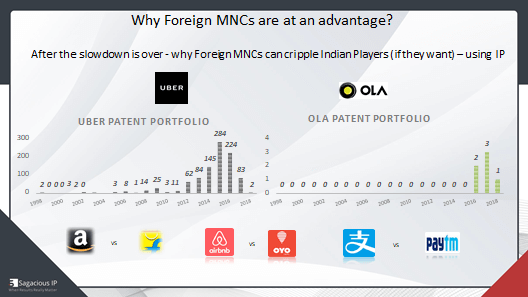
Another important thing is that foreign MNCs are finding it difficult to sue Chinese companies in China. As I said, one of my clients is out on bail just to accuse the company for infringing their products. So a lot of those companies are not coming to India. For example, if they want to sue Xiaomi, Xiaomi has India
as their biggest market. So they do not want to sue them in China. They want to sue them in India so that they can get faster resolution and they can hit them where it really hurts and they will actually then sue all the players including the Indian ones. So that’s why the threat is increasing for Indian companies.
The fourth is slowdown always found small litigation because they want to stop counterfeits and increase the market share. So, Covid-19 is very right situation when MNCs can come and ask you to shut your shops because you are infringing their IP rights. That’s what happened in US and many other countries post 2008-2009 recession. By that time, India had no IP regime. So it did not come to India.
But now, considering people know India has a good litigation regime, it might come to India and foreign MNCs continue to increase their filings. So, India is having faster grants. They’re increasing their manpower. So, foreign companies are taking all the advantages that they can to file in India while Indian companies are still not woken up.
So, situation is going to get worse in future if they do not pick up now and find there is opportunity for India where China losing trust. One study says that China is deliberately doing it, that they do not want the low-end manufacturing anymore. They have limited resources they want to focus on high-end manufacturing.
So, this means that with Modi government in place and with Make in India in place, we will see more and more opportunities and more and more companies coming to India for their manufacturing. So which is both an opportunity for many but for the established SMEs, it could be a big threat because once they come here, they become more serious about this market. They already have IP rights. So, it may be a difficult situation
And why foreign MNCs are at advantage. I just wanted to show an example of Uber and Ola. Uber has so many patents filed, including in India, and Ola has nothing. So if Uber wants, they can simply take Ola to task. They may be waiting for Ola to launch an IPO before they do this. Similar is the case with Amazon and Flipkart and somebody was asking about hotel industry. So, if you can give me the contact of the person I’ll share with them, what kind of patents exist in hotel industry after looking at the portfolio of Airbnb as they already have a good portfolio.
Similarly, Oyo has nothing and same is the case with Paytm and Alipay. Alipay has a decent portfolio of patents while Paytm has nothing.
Anuj: Vivek, as we are running out of time. So, I would just request you. So just in the next 2-3 minutes if you can give us just an idea that how government of India is supporting MSMEs, what kind of incentives are available to them in short, not more than 2 3 minutes. And then I would request all the audience that if they have any questions, please type your questions and send to us. So 5 minutes Vivek will take and 7 to 8 minutes we can take you a so Vivek, just one question I would like you to answer.
What are the MSME incentives which government is giving?
Vivek: So what I can say is, government is supporting MSMEs and they can get their IP rights protected for free of cost. How they can do it? They can file the patent, they can file the trademark and Ministry of MSME is offering up to one lac rupee as the reimbursement in case of Indian patent. In case they are able to get any foreign patent, they can get a reimbursement of up to Rs. 5 lakhs and for each trademark, they can get 10,000 rupees as reimbursement from the Ministry of MSME.
In nutshell, MSMEs can file their IP rights and get protected and get reimbursed from the government. So, it’s nothing to lose. So if anyone wants to know about this scheme, they can write to us and we will share the details on how to get it, how to get this amount reimbursed from the government.
Anuj: Thank you Vivek for sharing this. So, I received a request Vivek that some participants have been asking for a copy of all the benefits and all for trademark and global filing.
Question Answers
But I would like to open this now. I would like to open the forum for some QnA. So Yes, I have a question from Nishit. Nishit, are you there?
Nishit: Yeah, I’m there. Can you hear me?
Anuj: Yes, please. I would like to just introduce Nishit. Nishit was our YI Delhi Fast chair and Nishit also runs an IT company. Please go ahead, ask your question.
Nishit: So first of all, thank you, Sagacious IP team for an enlightening session and there are a lot of revelations for us. Quick questions to two of them. One is that I run an enterprise as company. And the last I consulted a company for getting my software process patented, they told me that there are very little used cases around in software patents, and there is no point going after this because litigation is very difficult. So, if you can throw some light in that direction, what is the process and is it really worth doing this?
Secondly, regarding trademarks what are the government benefits besides the patenting process for MSMEs for filing copyrights and trademarks?
Vivek: Should I take this question?
Tarun: I think I would just like to add something for the first question and then you can add to it. And then we can give next question, which you can answer completely.
So, Nishit I think the advice is not very wrong also that software patents are sometimes not very eligible for litigation, including in US. By the way, may I ask, what is your major market right now?
Nishit: Currently it’s all domestic and part of it is in Singapore, but that can change for any enterprise as business, especially operating out of India. You would like to harness the ability to go into much more markets which are not price sensitive. So in the times to come, there could be chances where you want to expand into Europe and North America.
Tarun: Understood. So I think I’ll let Vivek answer from the Indian perspective. But I’ll tell you that in US, I think these patents have written properly. So earlier there was a lot of unclarity on how to basically draft those patents and how to basically interpret those patents. Recently, there was a judgment called LS. There was a case named LS. After that, a lot of new guidelines have come in, in US, which kind of makes it very clear that what is patentable, how it should be patented, and how it should be enforced.
So, we have actually compiled a guide also around how to basically drop the right quality software and these kind of patents in light of the LS judgment. But I would like to say that these kind of patents are enforceable. IBM actually sued Groupon. Groupon, as you know collects coupons and those kind of things. So, IBM sued Groupon on a very basic kind of patent related to some reward points and Groupon had to settle for $67,000,000 with IBM.
And this is not a case which is alone. There are many more cases where Expedia was sued or Expedia sued someone, Booking.com kind of sued someone. So, those kind of things keep happening in software patents, if drafted properly, are enforceable.
Vivek you can add the Indian perspective as well as answer the second question.
Vivek: So, Nishit I think you might have consulted any IP lawyer probably before October 2019. I’m correct?
Nishit: That is correct. That was in late 2018.
Vivek: Okay, so what happened in November 2019, Delhi High Court has given a judgment that’s called the landmark judgment, wherein they have clarified which are the conditions that are present, so that software patents can be granted.
So, if your software has some component in it by which you are giving a better output, let’s say you have a software to increase the battery performance of your phone. So in that case, your software is eligible to get a patent, number one. Number two, although it’s a Gray area but after the judgment, things are now getting settled.
If you have any software invention, so you should try to file a patent number one and number two, the algorithm or the code, the object code or source code, part of it can be protected through Copyright also. You can get dual protection. The functionality component can be protected through patent and the code itself can be protected via Copyright.
Nishit: So, what if there is no new invention, but the process or methodology in which you conduct or operate the software is very unique? Is that also patetable?
Vivek: Yes.So it’s a gray area.So, I cannot give a very precise or direct answer to it.But yes, if there is a better output by using the softwareor the same hardware but you have done some tweaking and by doing so, if you are giving or getting better output,that can be patented or that can be a good inventionto file for it.
Tarun: It is generally a business method.So, it’s a business method patent and those guidelines are also not pretty clear.So if it’s a business method which makes something easieror doing something much easier, more transparently.So the major factor here is you haveto focus on the problem it is solving for example, if itwas, let’s say, insurance products.So you are actually now asking people to buy insurance online.So you need not focus on that. You Don’t say you can buy online or just that. You have to showthat what is the problem which is being addressed and youhave to actually approach it from the problem solution angle.
If you actually identify that it’s a significant problem and you can actually tie it, let’s say to monetary gains. Let’s say if we buy insurance online, so overall, this much amount of effort can be saved from our manpower, so it can impact the economy like this.
Those sounds very stupid, but that’s how the process works. So you have to really tie it to the problem in the solution. And if you can actually tie it to, let’s say manpower save, you can tie it to, transparency increase where you can tie to, let’s say the revenue that can be enhanced or profitability that can be enhanced. It becomes much easier to convince examiners to grant those kind of patents and later on, if you want to litigate also, those things can be very useful.
Vivek: I still on your second question, like, what are the benefits for MSMEs for registering trademarks? Right?
Nishit: Correct.
Vivek: So, there are two benefits, number one for corporates and big companies, the official fee for filing trademark application is Rs. 9,000 per trademark per class. For MSMEs, it’s just 50% like, Rs.4,500 per trademark per class. So this is benefit number one.
Benefit number two, you can get the amount reimbursed from the Government of India as Rs.10,000 per trademark per class after getting it registered. And these days, the registering a trademark is like, you can get it registered in less than six months of time. So this is like the fastest and you can file the trademark application, get it registered within six months, and get your amount reimbursed from the government.
Anuj: I have a question from Mr. Survesh Aggarwal. The question is that I am into packaging business. My question is, how much time does it take and what is the cost involved and do I have to open the patent details with the IP company as well?
So I think it is more towards he wants to understand that how much time would it take to file a patent? What would be the cost to file a patent? And would he have to disclose all the details to the IP consultant or the patent company to do that?
Tarun: Right. So that’s a very valid question. So coming to the last part first, that whether he has to disclose all the IP information to the IP company. I think it’s a good idea if you do that because we can then advise that what part should be disclosed in the patent, what part can be kept a secret while ensuring the strongest protection. But even if he does not want to share the exact details with the company like ours. So some companies what they do is because patent want that you should disclose how you are doing it, what you are doing to an extent that anybody who reads the patent can copy it and do it on their own.
So you are actually disclosing it to the public so they can actually reproduce it themselves while they cannot do so for 20 years because government gives you exclusivity. So that’s the basic principle of patents that you disclose everything to public and public can build further and humanity can progress while you get 20 years exclusivity on that particular concept. So here they also want you to disclose the best embodiment that what are the conditions, let’s say, in terms of thickness or whatever it is that this invention is actually performing the best. So, sometimes what you do is you protect the invention broadly. But when it comes to the conditions for practicing that invention, you do not provide the exact best condition. So you provide, Let’s say the secondary or third best scenarios there while keeping the best scenarios to yourself because that does not diminish your protection and those kind of details can be hidden from the IP company as well. But considering we are your consultants, I think it’ll be better to provide us all the details so we can guide because we will always sign an NDA and that NDA is kind of enforceable
Now second part, how long it takes. Now, Indian government has launched a fast track examination as well as accelerated patent grant. So there are patents which are granted in 9 months, there are patent which are granted in 18 months. But for that you have to qualify as a startup. So if you’re not a startup, then I think typical time will be 3 to 4 years. It will take for the patent to be granted, although the rights conferred by the patent can be claimed even before the final patent is granted
Coming to the cost. I think typically, depending on how complex is the invention. The cost can be anywhere between, Vivek, can you highlight that what is the official fee for filing a patent in India?
Vivek: For individuals and startups, it’s Rs.1,600, for MSMEs it’s 4,000, for corporates, it’s Rs. 8,000.
Tarun: Right, but you can expect that on a patent end to end, including professional fee, including official fee, because it will take a lot of iterations. Once you file, the Patent Office will come back with more objections, more questions. So it takes 3 to 4 years if you’re not a startup and go for accelerated examination. So for that period, I think your cost should be around Rs.1 lakhs per patent approximately.
Anuj: Very viable that by spending a lakh or two lakhs rupees. If you get some exclusivity and protect yourself for the next 20 years.
Vivek: Anuj, I want to add that you can get that Rs.1 lakhs direct from the government.
Anuj: Oh, even that can also be reimbursable.
Tarun: If you are taking your IP global, you want to file not only in India and outside, so government generally refunds 50% of the cost or up to Rs. 5 lakhs.
Anuj: Excellent. So, let me close this session now. We have already taken a lot of time. It’s 05:20, but definitely, thank you, Sagacious, Tarun, Vivek and Tanmay. I thank you so much for organizing this for us. I do not know if everyone is hearing me out, so just a very good news that Sagacious IP has agreed to open up a free virtual IP counseling tool for us, which we will send it across to all our YI Delhi members shortly by email to attendees and maybe to or whatsaap groups.
So through that, what you can do is that they have created a tool for us. It’s a virtual tool. They will be giving a number so you can dial in, and it’s a free of cost for YI Delhi. So, you can just reach out to them, and you can ask your queries and Council with them at free of cost.
Tarun: I have again and again mentioned this point that Sagacious, as a company has been relying for revenues from MNCs. So, we have customers in 45 countries. In India, our major purposes that we want to basically participate in the government’s goal of reaching $5,000,000,000,000 economy. So for us, working with Indian customers and such intelligent people in such a bright chance companies is a privilege for us. So anyways, we want to contribute to India’s growth story, and we would do whatever it takes in our capacity to help. And I’m very sure the kind of knowledge that we have and that we have developed over the years by working with companies like Amazon, as I mentioned, since the beginning of their journey. Like Xiaomi or Vivo since the beginning of the journey, this has really enabled us that what we can do and how we can win this war with innovation and IP.
Anuj: Thank you so much. Now, I take this opportunity to thank you, all of you, and all the participants for patiently hearing this out and thank you. So, Tanmay now we can close this.



